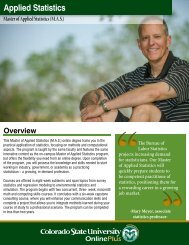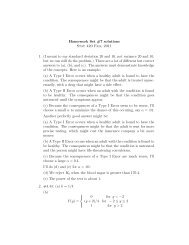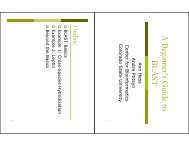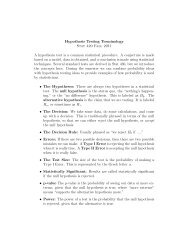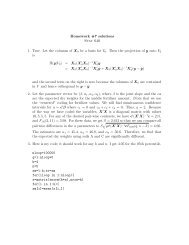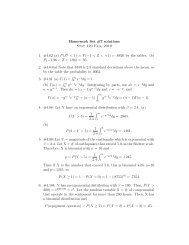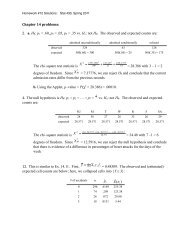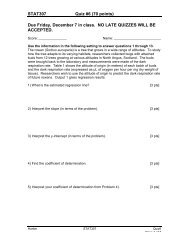Answers to Homework #5 - Statistics
Answers to Homework #5 - Statistics
Answers to Homework #5 - Statistics
You also want an ePaper? Increase the reach of your titles
YUMPU automatically turns print PDFs into web optimized ePapers that Google loves.
# code <strong>to</strong> simulate the null distribution of Fmax when the<br />
# sample sizes are 12, 8, 10, 10, 14.<br />
svec=1:5<br />
nloop=100000<br />
fmax=1:nloop*0<br />
nj=c(12,8,10,10,14)<br />
for(i in 1:nloop){<br />
for(j in 1:5){<br />
x=rnorm(nj[j])<br />
svec[j]=var(x)<br />
}<br />
fmax[i]=max(svec)/min(svec)<br />
}<br />
0 10 20 30 40<br />
4. The fit using two parabolas with vertex at the origin is shown in (a), with the<br />
residuals in (b). The hypothesis test gives p = .044, which is significant at α = .05<br />
but just barely. Because the residual variance seems <strong>to</strong> be growing in time, and<br />
because we expect the rust measurements <strong>to</strong> be more variable if the metal sits<br />
longer, we decide <strong>to</strong> use a weighted model. If we assume that the variance of y is<br />
proportional <strong>to</strong> x, the fit is shown in (c). It is not noticeably different than the<br />
unweighted fit; however, the p-value is now p = .074. The residuals look better, but<br />
now let’s assume that the variance of y is proportional <strong>to</strong> x 2 . The fit again looks<br />
very similar, but now we get p = .141.<br />
(a)<br />
res<br />
-5 0 5<br />
(b)<br />
y<br />
0 10 20 30 40<br />
(c)<br />
restr<br />
-4 -2 0 2 4<br />
(d)<br />
restr<br />
-2 -1 0 1 2<br />
(e)<br />
1.0 1.5 2.0 2.5 3.0 3.5 4.0<br />
1.0 1.5 2.0 2.5 3.0 3.5 4.0<br />
1.0 1.5 2.0 2.5 3.0 3.5 4.0<br />
1.0 1.5 2.0 2.5 3.0 3.5 4.0<br />
1.0 1.5 2.0 2.5 3.0 3.5 4.0<br />
To explain why the results are not significant after we weight the analysis, we point<br />
out <strong>to</strong> the scientists that most of the difference in the data is seen at month 4, where<br />
the paint A measurements (green dots) are smaller than the paint B measurements.<br />
If we don’t account for the fact that the variance is also higher here, these differences<br />
seem more significant. Notice that for the first month’s measurements, the means<br />
are about the same. When we weight these values more, the differences in paint are<br />
not significant.




